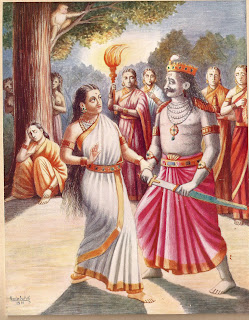Week 4 Story: Indrajit Battles Lakshmana
Figure 1: Depiction of the Ramayana Wikipedia
Indrajit calmly turned, arrow still nocked, and loosed his arrow at an his target. He did all this, just asa he had trained for hundreds of thousands of repetitions. He did it without thought, without the need to think, as he had long since ceased to need to think to hit his target. And for the first time, in a long time, his arrow missed its mark.
Lakshmana slipped right as the Indrajit released his arrow and countered with his sword. He slashed at Indrajit's feet, and then thrust at his head But Indra was danced out of the first attack and deflected the second with the bow in his hand. The Lakshmana's long blade bit into the bow, splitting the wood, and shattering it. Indrajit threw the bow at Lakshmana, giving him a few precious seconds to scramble for his own blade.
Now wielding a proper weapon, Indrajit launched a counterattack. He swung his weapon in furious circles Lakshmana. Lakshmana blocked attacks coming from the right and left, each time their weapons clashed sparks ignited and the air was filled with the sound of colliding metal. As Indrajit threw slashes at his enemy, he quickly stopped his blade and thrust low. Lakshmana leapt over his opponent and the two clashed in the air, and when they landed, both had been wounded.
But Indrajit was not satisfied, and he charged Lakshmana, slashing the ground as he did so and sending debris at his opponent. Lakshmana was prepared for this, and he deftly avoided his opponent's incoming attack. They clashed again, and the entire world shook from the impact. As they disengaged, Lakshmana noticed an elbow protruding out of Indrajit's guard. Lakshmana aimed a single well placed slash at that elbow, severing Indrajit's arm. Indrajit roared in agony and dropped his sword, and as he did o, Lakshmana stpped in and severed his head.
Author's Note
I recently watched the final battle from sword of the stranger. That's literally all that happened. I'd like to pretend that there was some greater meaning to the story than mashing the battle between Lakshmana and Indrajit with Nanshi vs Luo-Lang, but there isn't.



You mention in your author's note that you'd like to pretend that there was some greater meaning to the story, but what if you gave that to the story? As an author retelling a story, you are not bound by the original one. You could give Lakshmana a reason to want to kill Indrajit. In fact, if you did, I believe it would add a lot of depth and intrigue to the story. The scene of Indrajit calmly loosing an arrow at an assassin is such a powerful image, but it could be even more impactful with a bit of context. As a reader, I was also left curious what let Lakshmana beat Indrajit, as Indrajit has clearly had no problem beating assassins in the past. What makes Lakshmana different? I believe adding these elements could take this from a striking fight scene to a captivating story.
ReplyDeleteEric, great job on writing out an action sequence. I felt like I was taking in a cut scene to a future edition of Mortal Combat. In your story, we immediately learned that Indrajit values practice and training over talent or contribution. Likewise, we learn that we are witnessing the beginning of a possible assassination attempt. But, at the same time, Indrajit is not going to be an easy target. In the end, after reading your author’s notes, I wondered if there can very easily be a moral to the story? Through your description, Indrajit has found himself complacent through all the attempts on his life. Despite his constant practice, he has missed his mark. Why is that? In addition, at the end, Lakshmana sees a misstep in Indrajit’s form and seizes it with a mortal blow. Perhaps, your story could be a lesson in the difference in “practice” versus “perfect practice makes perfect.” A few narrative sentences explaining this could transform your action scene into a lesson.
ReplyDeleteHi Eric, I think you did a great job with this story, particularly using descriptive words. The way you wrote the story, adding in lines such as "giving him a few precious seconds to scramble for his own blade" and "sending debris at his opponent" allowed for a more in depth visual that you provide to the reader, giving us a sense that we were there. This allows for the story to flow very eloquently and become something more than just a basic story you have written, but rather more of a short story that has description that makes the reader feel more involved. Great job!
ReplyDelete